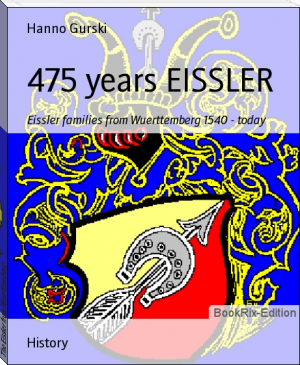The Eissler from Wuerttemberg by Hanno Gurski (sight word readers TXT) 📕

- Author: Hanno Gurski
Book online «The Eissler from Wuerttemberg by Hanno Gurski (sight word readers TXT) 📕». Author Hanno Gurski
The Wuerttemberg Eissler
1550 - 2015
Albert Richard Eissler of Sindelfingen
"Your Ancestors And Descendants"
Single Birthday edition
August 1984
Johannes Eissler of Oßweil
Descendants in the Albstadt area
Pedigree
November 1995, out of stock, 143 pages
444 Years Eissler
Pedigrees of all the families
1. edition 1996, out of stock
357 pages, 100 pages registers
2. updated edition 1998, out of stock
600 pages, 120 pages registers
Engl. Addendum, 45 pages
Eissler
Anniversary edition "30 Years Eissler-Research"
Updated and completed edition 2015
on the way
Table of Contents
Table of Contents page - 9 -
Prefaces page - 11 -
Chapter 1 Something About Sources page - 15 -
Chapter 2 Origin of Our Surname page - 17 -
Chapter 3 Eissler, Eißler or Eiszler? page - 19 -
Chapter 4 History and Geography in Germany Seite - 21 -
Chapter 5 System of Representationpage - 27 -
Chapter 6 Details of Producing This Book page - 29 -
Chapter 7 Word of thanks! ! page - 31 -
Useful Literature, Addresses page - 33 -
Sippen books, family books Seite - 34 -
Part A Die Talheimer page - 35 -
Part B Die Willmandinger page - 265 -
Part C Die Holzelfinger page - 285 -
Part D Die Öschinger Seite - 347 -
Part E Die Münzesheimer page - 371 -
Part F Die Oßweiler page - 387 -
Historian Illnesses page - 533 -
Professions and other words page - 560 -
Relativeships page - 573 -
Addresses of EISSLERs world wide page - 581 -
Registers Eissler´s on the thousands Eissler page - xxx -
Family´s and spouses´ names page - xxx -
Places page - xxx -
English Translations + Abriviations page - xxx -
Preface of the 3.rd edition
On the way - I´m waiting for my friend Ed Maul
"translate" my school English into readable English.
Hard work . . .
Chapter 1
Something About Sources
Most of the newer dates have been given to me by the families in question who also agreed to the publication and who have been waiting for the publication of a book about their familes with great expectancy.
Here it became apparent again that our old and oldest family members are a never ending source of information.
During one of my many interviews, a 91 year old lady was not only able to give the names and dates of birth and marriage of all her brothers and sisters, nephews and nieces (almost two dozen) but also those of her parents and grand parents. This information had al- most four new generations, with some 150 years of family history. Other family members added to great aunt´s information about the next three generations right up to today.
In my opinion this is a sign of the strong family ties of former generations. It is unfortunate that young people are often not interested in family history and sometimes are not even aware of their mothers or grandmothers family name.
The data in the book is published with the consent of the persons therein. People not wishing their data to be published are merely mentioned by name, without any further details. I must say that in the hundreds of inquiries I made I came across only one such case !
Also all information of a more intimate or embarrassing nature such as certain illnesses, divorces or suicide of family members in the recent past have been recorded they but are not published.
Parish registers were the main source of information for older dates. Luckily in Baden - Wuerttemberg the sources are so good that the lineage can be traced back as far as the 16th century.
Registers of land ownership and store books were another source of information but the problem here is, that the people are only mentioned in connection with certain happenings such as tax payments, inheritance matters, etc. Family ties are rarely noted in these records.
On the other side the naming new borns in these times (around 1600 and earlier) were rather monotonous. In may cases families teemed with Hans and Michael or Anna and Maria without their relationship to each other being apparent.
A further difficulty is that many people had nick names resulting from their occupations or their bodily characteristics (some such examples the Black Matheis
or the Fat Michele
). These names were recorded in the parish registers. But they sometimes changed during the course of a life depending on the changing situation.
For example Johannes Eissler was first called the Cobbler-Jones
(Schuster-Jones) because he was a cobbler by profession and another Johannes of the same age lived in the town at the same time. After his marriage he took over the inn Crown from his in-laws, becoming the Crown-Hans
(der Kronen-Hans) for many years.
In his old age he became Old-Hannes
(Alt-Hannes) to differentiate between him and his son Johannes, who in turn took over the Crown. And the son again shows up as Crownhans
(Kronenhans) or as Younghans
(Junghans), and closing the circle, eventually as Oldhans
(Althans).
This shows that the same name does not have to mean the same person - vice versa that different names mean different persons. Without further comparisons with other records or information from other sources there is no certainty.
The custom still lives on in some regions. A friend of the family living in the Black Forest who is a butcher by profession is only called "Koppe-Max" just like his father and his grand-father before him even though his christian name is Dieter and his elder brother is named Max. Here again the family resemblance and the same profession for over three generations play a big role. And to continue this tradition he baptized one of his three daughters on the name Maximiliane!
The names of the wifes are another problem.
Right up to the last century the woman was often only called by her christian name and by the profession of the husband.
This would look like:
"Cramer-Cathrin, former wedded housewife of the deceased Schulze-Mattheis"
The assumption lies near that we are dealing with Katharina, the widow of the town major (Schulze or Schultheiß) named Matthias Cramer. But what is one to do if it turns out that during the time in question neither a town major Cramer or Kramer existed nor that such a wedding was registered?
One puts aside the found Kramer-Cathrin as a "dead point" . . .
That this Cathrin was in truth
"Anna Catharina, daughter of Johann Widmann and Anna Maria Majer of Oeschingen"
who as the widdow of the former Schultheiß Matthäus Eissler in her later years had a grocery shop (Krämer- laden) was found out later just by chance.
Even though some parish registers have been lost by fire or by the effects of war one can often close gaps by comparing with other records. During the 30 Year War (1618-1648) it seemed common for marauding soldiers to use pages from the parish registers for lighten- ing up fires or for some other unsavory purposes).
On the other side misinformation or gaps in information from living persons could sometimes be filled in or corrected by comparing them with the actual parish registrations.
The works of other authors were a big help in finding dates of the spouses. Many good Suabian names appear that already have been published by others. A further source of information were the regional books of kinship of many towns. I did not find it necessary to verify the information found here but merely updated the in- formation wherever possible.
As a rule, comparisons with other dates from different sources showed them to be true.
Chapter 2
Origin of Our Surname
Permanent family names first appear in the 8th and 9th century in the upper Italian towns. After the decline of the Roman name system during the times of the great migration a new system emerged. Permanent names appear in the south of France in the 10th century and in the Roman part of Switherland one hundred years later. In Germany, double names gradually became common from the 12th century on, slowly spreading from the West and South and by around 1600 they were common in most of the German territories. However in Friesland (Frisia) inherited family names came much later and had to be enforced by law.
Whereas the sources for family history only go back a few centuries family names, as described, much farther. Therefore it is not wrong to say that the name is the oldest record of family history. It can give information about profession, home or appearance of the ancestors during the times of the birth of family names.
Especially the spoken form as well as the differences in dialect give information about the origins of the ancestors. Some names have been changed (mostly by migration) in that they were adapted to the new surroundings.
The first people who worked with iron (Eisen) were presumably called Eissler. These people, belonging to the original craftsmen, produced items for the daily life. Through their work, the fragile household items of clay, wood or bones were replaced by ones of iron. This cultural step brought forward many professions which in turn raised the living standard and was responsible for the further development of mankind.
Now the thick furs could be sown together into shoes or quivers, invaluable help for hunting, the same as iron arrow heads. Wooden plows were replaced by ones of iron.
One can say without exaggeration that the course of human civilisation would not be the same without the people who had the knowledge to work with iron, the Eissler. The transition from the stone age into the iron age made possible progress of mankind. (Whatever one may think of it)
The specialisation of the craftsmen probably took place later, possibly first into producers and processors of iron.
Contrary(?) to the above said the author H. Kapf in his book "Schwäbische Geschlechtsnamen" ("Suavian Family Names
") interprets the name Eissler as ironmongers.
An Eissler (ironmonger) produced pots and pans, knives and arrows. The shoeing of horses with hooves was also part of his job. He was responsible for the production and repair of the peasants items used in their daily life. The step from producing to selling does not seem a big one.
Few Coat of Arms
In the records "Nachträge zu den Aufzeichnungen des Alten Siebmachers
", in which many coat of arms go back to the Carolingian times there are also listed some 16th century Eissler coats of arms.
However, without exception, they stem from families or persons from Bavaria, from the families of Nuremberg which are in no way connected (yet) with the families of Wurttemberg.
They are illustrated just to show the meaning of the name Eissler.
The wrought bars as well as arrow and horse shoe show the close connection of the carriers of the name or their ancestors to the material iron.
a) coat of arms of an unknown (likely Bavarian) name bearer.
b) coat of arms of Jobst Eissler to Nuremberg, Bavaria.
c) coat of arms of Jeremias Eissler, sculpturer in Nuremberg.
d) coat of arms of Oswald Eissler, goldsmith in Nuremberg. His son Leopold also a gold smith died 1631 in Ulm (Wuerttemberg area!)
Chapter 3
Eissler, Eißler, or Eiszler?
The spelling of the names changed during the course of the centuries.
The very first recordings of persons of this





Comments (0)